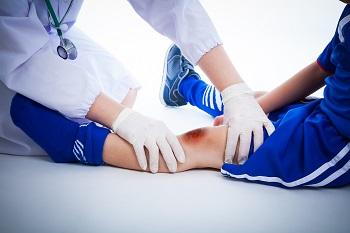Millions of children across the US regularly participate in some kind of sport. No matter whether your child is a dancer, gymnast, soccer player, or football player, the goals of parents are always the same: to keep their child healthy and to prevent injury. Having a pediatrician that you turn to regularly for care is invaluable, as this trusted medical doctor can also provide you and your child with guidance and counseling to ensure that you are taking all the precautionary measures necessary to prevent sports-related injuries in your little one.
Caring for Childhood Sports Injuries
With millions of kids also visiting the hospitals every year for sports-related injuries it’s important to acknowledge that the need for proper injury prevention practices is particularly crucial for children and teens. The most common sports-related injuries include repetitive motion injuries (e.g. tendonitis), ankle sprains, broken bones, and concussions.
Since many of these conditions are the result of overuse rather than injury symptoms may appear gradually over time. Therefore, it’s important to listen to your child when they complain about pain or other issues they are having. It’s also important that kids have ample time to rest and heal. If they don’t this can also put unnecessary stress the body and leave them prone to injury.
Minor sports injuries can often be treated with rest and home care. The RICE method is often used for treating minor to moderate sports injuries. RICE stands for rest, ice, compression, and elevation. Children may also find relief through non-steroidal anti-inflammatory medications such as ibuprofen, but it’s important to talk with your pediatrician before starting your child on any new medication.
While you may wish to treat your child’s symptoms at home it’s also important to know when to turn to a pediatrician. Call your child’s doctor if their symptoms do not improve with at-home care, if symptoms get worse, or if their symptoms affect their training. These symptoms also require immediate medical attention:
- Severe pain and swelling
- Deformity (e.g. a misaligned bone)
- Numbness, tingling or weakness
- Trouble walking or putting weight on the injured part of the body
Preventing Injuries
As any pediatrician will tell you, it’s always better to prevent injuries than to treat them once they arise. There are a variety of measures you can put in place to reduce your child’s risk for injury. These injury-prevention tips include:
- Making sure that your child gets a physical exam from their pediatrician at least once a year to make sure that they are healthy enough for physical activity.
- Make sure that your child is getting ample training throughout the year so that once the season rolls around their body will be ready for the demands of their chosen sport.
- Make sure that your child is wearing the appropriate footwear and protective gear. This includes helmets, mouthguards, shin guards, and other padding.
- Your child should also stretch and warm-up for at least 10-15 minutes prior to game time. A proper warm-up can greatly reduce injury.
If your child is experiencing pain, swelling or other problems as a result of a sports injury don’t hesitate to give your pediatrician a call today. Catching and treating sports injuries right away can prevent further complications.

